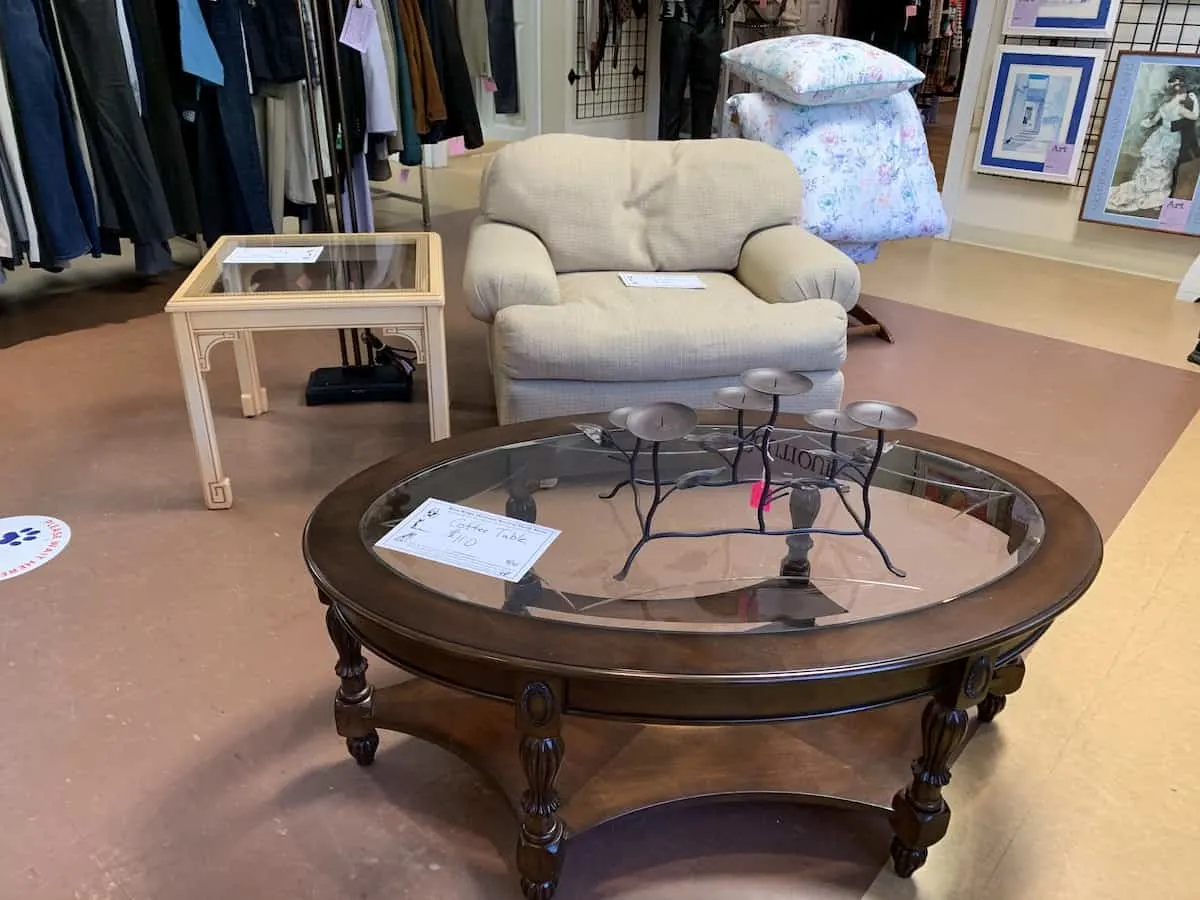Must-know tips for buying used furniture at thrift stores, garage sales and online marketplaces.

Purchasing used and second hand furniture is a great way to save a little bit of money while decorating your home. Yet, purchasing used furniture can sometimes be a gamble. Which is why you must know these tips for buying used furniture.
While some used furniture is perfectly safe to bring into your home, there are a few things to look out for when purchasing secondhand items. Make sure to check these six things on a piece of furniture before handing over any money.
Be sure to check out my $3 recliner that I bought and how I made a drop cloth cover!
1. Check the Wood
The first place to look when inspecting used furniture is the wood. Start by determining what type of wood the furniture is made from.
Soft woods, like pine or MDF, typically indicate that the furniture is poor quality, which means it probably won’t stand the test of time. Since these woods are softer and more porous, they’re more likely to warp and become unlevel over time.
These cheaper woods also tend to yellow as they age, which is a good indication that the piece of furniture is past it’s prime.
On the other hand, furniture made of hard wood, like oak or maple, often (but not always) indicates more solid construction.
But even if the piece of furniture you’re inspecting is made of a hard wood variety, you’ll need to inspect the condition of the wood. Look for areas where the wood has buckled, as well as any deep scratches in the finish. These flaws can be difficult to repair.
It’s also a good idea to check all the drawers and cabinets on your furniture for mold and other issues inside the piece before you make your purchase.
2. Look for Labels
One of the biggest reasons most people buy used furniture is to save money and purchase something that otherwise might be out of their budget.
Make sure you’re getting what you pay for by checking the furniture for a tag or label before buying. Knowing the manufacturer of the furniture can help you determine its quality. So it’s always a good idea to check for a maker’s mark before you buy a piece of used furniture.
And if you don’t recognize the brand, do a little bit of research before making your purchase to ensure you’re getting the best deal for the price you’re paying.
3. Check for Quality Craftsmanship
While it may be difficult to know how well a piece of furniture is built, there are a few tell-tell signs that can help you spot a piece of high-quality furniture:
- Solid wood construction: Furniture made of solid wood (not particle board or composite wood) is a great indication that the piece is sturdy and well-made
- Dovetailed joints: Joints that interlock with each other, also known as dovetailed joints, are another indication the piece is well-built
- Dowels or screws in joints: While dovetailed joints are the best option for furniture construction, furniture put together with dowels or screws holding the joints in place are usually solid as well
- Level with the floor: When a level is placed on top, it should not be askew. The furniture should not wobble or squeak when moved.
4. Look for Bed Bugs
If you will be purchasing used upholstered furniture, always take the time to check for signs of bed bugs.
While bed bugs often hide inside the upholstery, they leave a few signs that may be visible on the outside of the furniture. When inspecting upholstered furniture, use a flashlight and magnifying glass to look for:
- Small black dots or reddish streaks left on the exterior of the furniture left from feedings
- Molted skin on the back or underside of the furniture
- Bugs or eggs hiding in the cracks, seams, and joints
If you notice any of these signs of bed bugs, skip the purchase. No deal – no matter how great – is worth the risk of bringing bed bugs into your home.
5. Sit on It
Don’t purchase any piece of furniture before testing it out first!
In addition to making sure the furniture is comfortable, using the furniture will also help you test to make sure it works for you. For chairs and couches, make sure the furniture can hold your weight.
When testing cabinets and drawers, take the time to pull out each drawer and open each cabinet. Make sure everything works as it should (or can be easily fixed) before buying a piece of furniture.
6. Smell It
Bringing a smelly piece of furniture into your home is definitely something you don’t want to do. And while there are some smells you may be able to get out, lingering odors like pet smells and smoke are much more difficult to remove.
Before you make your purchase, make sure to smell the piece – especially if you’re purchasing upholstered furniture. Removing bad odors from a piece of secondhand furniture may be more work than you want to put in just to save a few dollars.
7. Don’t Be Afraid of DIY Projects
If you can get a really great deal on a piece of furniture that’s not so pretty, don’t be scared about doing some DIY upgrades.
I refinished a damaged wood table and the results were great!
Adding legs to cube storage shelves is a great way to add personal style!
Here’s how I painted a glossy wood kitchen table without sanding or priming first.
You might also like this distressing technique using vaseline.
And this thrift store table looks modern after using chalk paint to refinish it.

